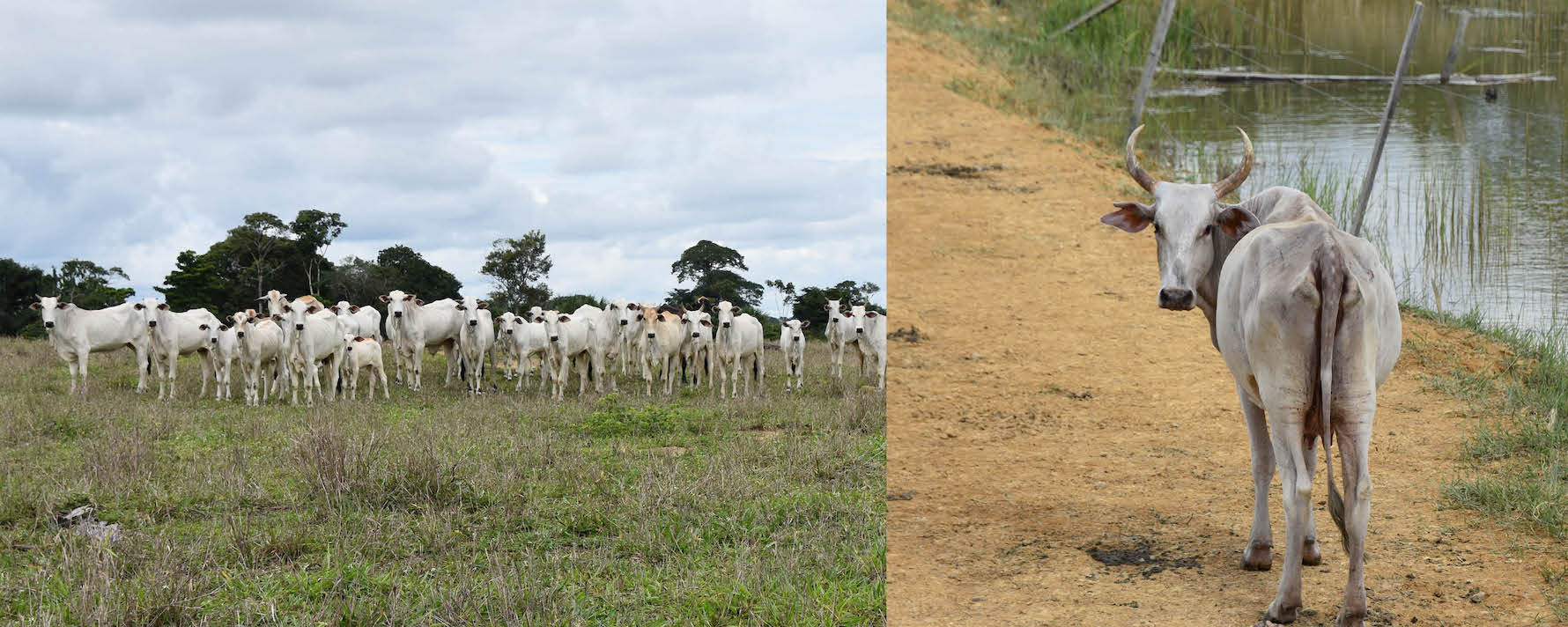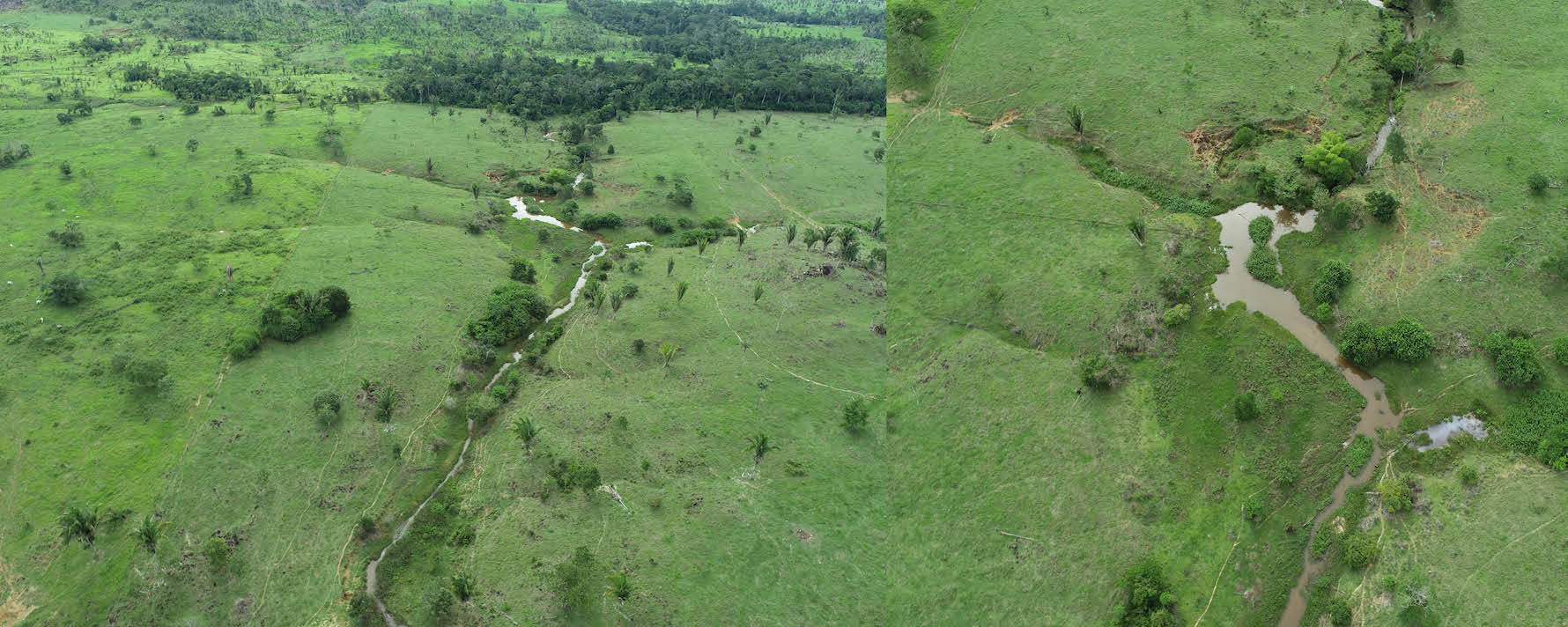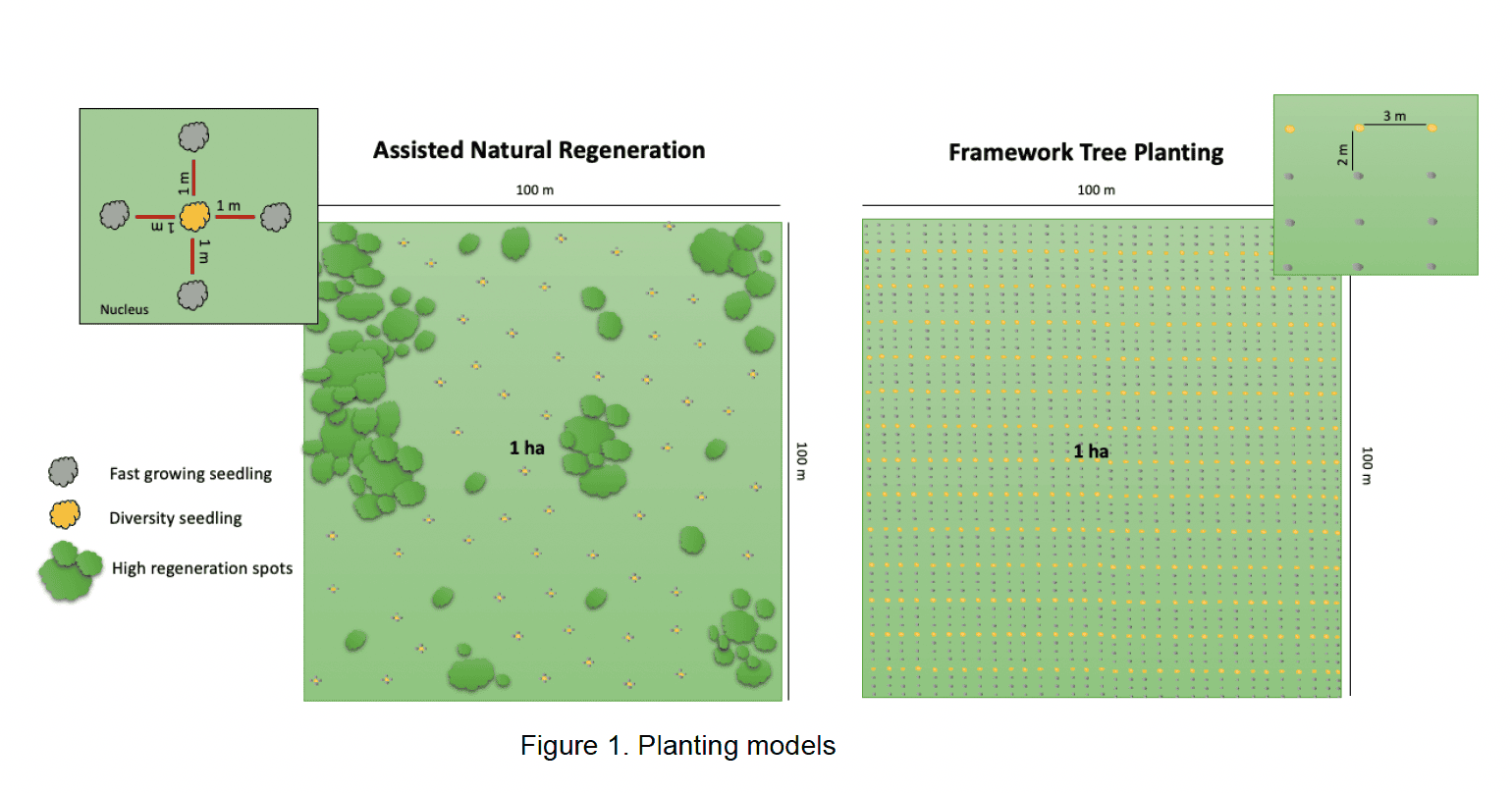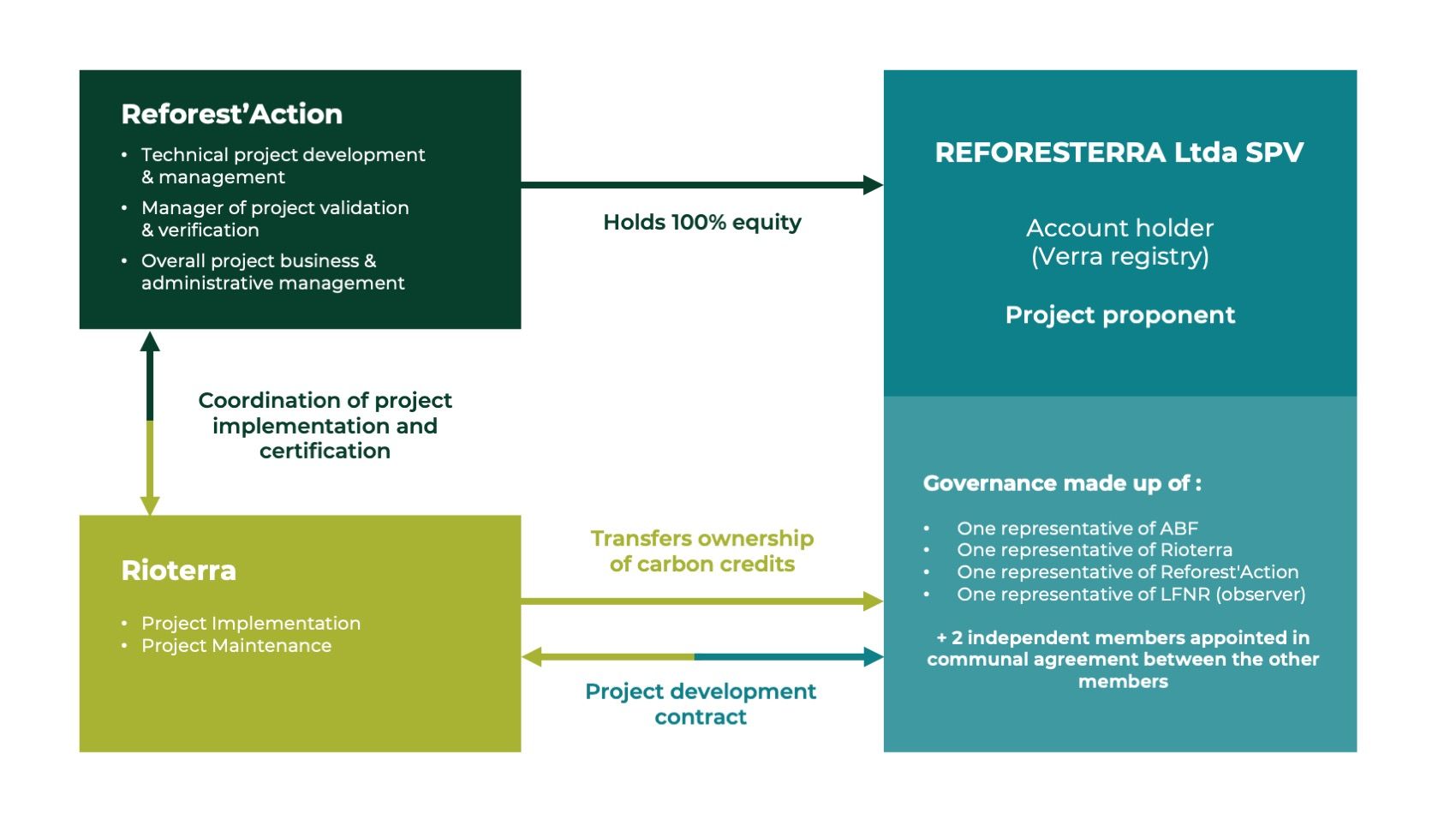Co-developed by Reforest'Action and the NGO Rioterra in Brazil, the ReforesTerra project has been validated, according to the VCS (Verified Carbon Standard) and CCB (Climate, Community & Biodiversity) standards. This validation is the result of several months of work and certifies that the project meets the requirements of the certification body. The project falls within the ARR (Afforestation, Reforestation & Revegetation) typology assigned to projects that develop forest carbon sinks by restoring vegetation cover through planting or assisted natural regeneration. The aim of this project is to restore forest cover in the Baixo Rio Jamari watershed by creating 2,000 hectares of secondary forest on degraded agricultural pastures. The expected impacts go far beyond the climatic aspects: the project will have a positive influence on the region's water system, native biodiversity, and the well-being of local communities.
ReforesTerra: a large-scale project in Amazonia
The ReforesTerra project in Brazil is anchored in the southern region of the Amazon rainforest, in the state of Rondônia. Whereas the region was almost entirely covered by forest, only 40% of the original forest cover remains in the project area.

Understanding the local context
In Brazil, deforestation is linked to several major historical events. As of 1970, the creation of the Institute of Colonization and Agrarian Reform (INCRA) reflects the country's determination to massively develop agriculture and extend the agricultural frontier over the forest. Through land fragmentation and the development of major roads, the state of Rondônia becomes the cradle of a large-scale agricultural colonization policy. Later, in the 21st century, the arrival of agribusiness in the Amazon marked the beginning of industrialized agricultural production, driving indigenous peoples further and further away.
Agricultural colonization in the state of Rondônia has radically transformed the region's landscape, socio-cultural patterns, and dynamics. It has altered communities' relationship with nature and given rise to various territorial conflicts between traditional populations, migrants, and land grabbers. Today, the main drivers of deforestation in the region, as elsewhere in the Brazilian Amazon, are cattle ranching and large-scale cultivation of agricultural products.

Specific features of the project area
The ReforesTerra project is located in the heart of a remarkable water zone: the Baixo Rio Jamari watershed. The Jamari River, which is 563 km long and drains an area of almost 30,000 km², is a tributary of the Rio Madeira, one of the most important rivers of the Amazon basin. The region is also a key passageway for "flying rivers", these volumes of atmospheric water carried by the wind over the Amazon rainforest. As a result, forest degradation and deforestation in the area are reducing water supplies in the southern half of Latin America**.

The project area is also characterized by a high level of biodiversity, although steadily declining. Open and dense Ombrophilous Forests are found, both characterized by the discontinuity and height of their canopies. The native Amazonian flora contains an impressive number of tree species per hectare. As for wildlife, the area is home to over 100 species of mammals, 500 species of birds and 90 species of amphibians*. In addition, the Rio Madeira boasts the greatest diversity of fish in the world***.
Comprising seven municipalities, the project's boundaries are home to roughly 180,000 inhabitants****, a figure that has almost doubled in the last twenty years. Cattle breeding is the primary source of income for almost half of the rural population, making it the region's leading economic activity. The limited remaining land is used for soybean, coffee and cocoa production. Data available in the region testify to the lack of job opportunities: less than 20% of the working-age population was employed in 2019.
*Rioterra, 2019 **Zemp et. al, 2014 ***Ohara et al., 2015 ****Census conducted in 2022
Brazilian Forestry Code
In the second half of the twentieth century, the Brazilian State establishes compulsory conservation zones on every farm in order to protect biodiversity and reduce land-use conflicts within indigenous reserves. These areas, then defined by the Brazilian Forestry Code, comprise Legal Reserves (LR) and Permanent Preservation Areas (PPA). A LR corresponds to a percentage of each agricultural property where the forest must be maintained, while a PPA aims to protect to the greatest extent possible areas of high ecological interest, such as riverbanks. In the early 1990s, Rondônia's federal government introduced an Agricultural and Forestry Plan (PLANAFLORO) in line with the state's socio-ecological zoning, with the aim of favoring the agricultural community while promoting sustainable, integrated development.
While this law is still in force, it is in fact little respected. This is due to a lack of resources and conviction among smallholders. However, in the face of repressive measures, such as the ban on obtaining bank credit, the need to protect the forests on their land is becoming increasingly obvious for communities. By giving them the means to restore the forests, the ReforesTerra project will help farmers to comply with Brazilian regulations.
Restoring the Amazon rainforest
In the Baixo Rio Jamari watershed, riparian lands are mainly covered by degraded and unproductive pastures, with isolated residual forests scattered here and there in the agricultural landscape. The ReforesTerra project aims to restore 2,000 hectares of privately-owned land by engaging landowners up to 5 kilometers beyond the geographic boundary of the watershed. The parcels selected must include one or more legal conservation areas (LR or PPA), covering at least 10% of the total surface area.
Forestry work
The project's main activity is to create secondary forests by planting over 90 native tree species from a local nursery. Starting at the end of 2022, reforestation work is based on two distinct techniques:
1) “Framework Tree Planting”: this involves replanting a mix of fast-growing species, which will rapidly develop the forest structure, and slow-growing species, which will create an ecosystem conducive to future natural regeneration. This high-density planting technique is applied in 75% of the project area.
2) “Nucleation”: in the remaining 25%, where spontaneous development is more likely, assisted natural regeneration is favored. Nucleation is an innovative restoration technique which involves stimulating forest regeneration and seed dispersal by planting trees in strategic locations, while encouraging the succession of existing trees.
Planting activities will take place from November to March, during the raining season, every year for 3 years.

For both models, tree planting is carried out by mobilized landowners, to whom the seedlings are distributed. Soil preparation, monitoring and maintenance of the trees during the first two years are carried out with the support of Rioterra's technical team, who accompany the farmers every step of the way and ensure the sustainability of the project. From the third year onwards, the good health of the trees becomes the responsibility of each owner, while Rioterra continues to carry out annual monitoring.
Mobilizing landowners
The ReforesTerra project relies entirely on the commitment of local farmers who own their land. Members of the Rioterra team, known as "project extentionists", regularly visit agricultural properties to convince farmers to contribute to forest restoration. The project objectives are explained to the interested parties, who are then given the opportunity to arrange a farm visit to verify their eligibility. A contract is then signed between the volunteer farmers and our partner Rioterra. The terms of the participation agreement are clearly spelled out, specifying the obligations of both parties. The landowner accepts that the project carried out on his land is under Rioterra's control, and must therefore allow access to the area. He also acknowledges that the Brazilian Forestry Code is applicable to his property, and that future deforestation of his land will result in non-compliance with this law. He therefore undertakes to properly maintain the trees planted and to prevent hazards in the long term. If the land is sold, the contract is transferred to the new owner.
In return, farmers will receive "Payments for Ecosystem Services" (PES) every year from 2026 to 2052, as a reward for their contribution to restoring forest ecosystems. By giving up part of their land to plant trees, they incur an opportunity cost, which is why PES payments are proportional to the reforested area. However, payments are conditional on the successful completion of the project. In addition to this annual contribution, participants will be provided with all the equipment needed to plant and maintain the forest: fences, wire mesh, tools, etc.

Acting beyond climate
Positive impacts of this restoration initiative go far beyond the climatic dimension. In addition to increasing carbon stocks, the ReforesTerra project will primarily protect water resources in the watershed, but it will also help restore native biodiversity and strengthen the economic and material capacities of landowners.
Impact on climate
The ReforesTerra project is being developed with the ambition of mitigating climate change through the creation of permanent secondary forests on deforested land. The average carbon sequestration target is 24,516 tons of CO2 equivalent per year, for a total of 735,491 tCO2e, or 367 tCO2e/ha, over the 30-year credit period. The planting of a rich selection of native tree species aims to increase the forest's carbon storage capacity, not only in the trees themselves, but also in the shrubs and forest soil.
During the life of a carbon project, the amount of carbon stored in the planted trees is monitored. Every three years, trees with a diameter of over 5 cm are counted and carbon stocks are calculated using complex allometric equations.
Impact on water
The project has been developed in an important riparian zone and thus focuses on improving the quality and increasing the quantity of water available in the region. The depletion of water resources and water usability is a growing challenge for the local population, especially for farmers.
As a major co-benefit of the ReforesTerra project, the protection of rivers and streams will be monitored using several key indicators: flow velocity, dissolved oxygen, pH, temperature, etc. Ten water points have been selected to receive these measurements every three years. Tracking the evolution of results over 30 years will enable a concrete and precise assessment of the project's impact over time. In addition, some 2,100 people should benefit from improved water quality and/or better access to drinking water thanks to the project.
Impact on biodiversity
Through reforestation and assisted natural regeneration, the project will enhance the area's floristic diversity and promote the conservation of native species. The restoration of a dense forest featuring a closed and diversified canopy will ensure an ecological continuity with the relict forests. This will provide a home for many of the region's most distinctive bird species. Ornithological studies based on bird songs will be carried out at ten focal points in the project area. An inventory will be carried out every 3 years as part of the project monitoring plan.
Impact on communities
Socio-economic impact is another pillar of the ReforesTerra project. The ambition is to support 600 landowners in reforesting their farmland. In addition to the economic support provided in the form of Payments for Ecosystem Services (PES) and the opportunity to comply with the Forestry Code in force, the project will also provide jobs. Initially, 37 people from local communities will be employed full-time, and a further 12 part-time, in the nurseries or as project extensionists. Farmers will also benefit from the planting of species providing non-timber forest products, such as fruits. These various components will generate a positive impact for some 1,500 indirect beneficiaries.
In addition, the project aims to empower the committed farmers by training them in reforestation methods: planting, maintaining, and protecting forests over the long term. Capacity-building for landowners will also include fire prevention, involving various fire-breaking techniques.
ReforesTerra: a project developed by Reforest'Action
Since 2021, Reforest'Action has been working to develop the ReforesTerra project. It falls within the ARR (Afforestation, Reforestation & Revegetation) typology assigned to projects that develop forest carbon sinks by restoring vegetation cover through planting or assisted natural regeneration. By promoting carbon sequestration, the project contributes to achieving carbon neutrality on a global scale.
In 2023, ReforesTerra was audited and validated by an external auditor according to the VCS (Verified Carbon Standard), one of the world's most widely used voluntary carbon offset standards. This standard, managed by Verra, an American non-profit organization, guarantees that the carbon sequestered by the project complies with a certain number of quality criteria. The project will be verified by VCS every three years for 30 years. Each verification will generate certified carbon credits corresponding to the amount of carbon actually sequestered by the planted trees. ReforesTerra also benefits from Verra's CCB (Climate, Community & Biodiversity) certification, which attests that the project generates positive impacts on climate, local communities and biodiversity.
ReforesTerra is a so-called " grouped " project, meaning that it can be expanded in the future if the additional hectares of land meet the eligibility criteria previously validated by the standard. In addition, the project follows the AR-ACM0003 methodology entitled "Afforestation and reforestation of lands excluding wetlands". This method provides the fundamentals of the project, defining, for example, the carbon pools (trees, shrubs, dead wood, etc.) and co-benefits to be taken into account.
Establishing solid governance

To bring the project to fruition, Reforest'Action has created an SPV (Special Purpose Vehicle), to enable the project to be deployed on Brazilian soil. Under Brazilian law, this structure is called REFORESTERRA - Restauração de Ecossistemas Florestais Ltda.
Through REFORESTERRA Ltda, Reforest'Action has teamed up with Rioterra, a Brazilian study center working towards a development model in the Amazon region that combines nature conservation and sustainability with the improvement of local populations' quality of life. As co-developer, Rioterra is responsible for implementing the project in the field and ensuring the link with local farmers. The roles of each party are defined in detail in a contract between Reforest'Action and Rioterra and the implementation and certification of the project being the result of their close collaboration. The project is financed by two investment funds: ABF (Amazon Biodiversity Fond) and LFNR (L'Oréal Fund for Nature Regeneration). Both Rioterra and the project's funders are members of REFORESTERRA Ltda's governance and take part in decision-making concerning the SPV.
Reforest'Action's role
In the context of carbon project development, REFORESTERRA Ltda plays the special role of "project proponent". According to Verra, this status designates the organization that bears overall responsibility for the project and can demonstrate its final completion. In other words, through this SPV, Reforest'Action is in charge of all aspects of project management and general coordination: requirements, objectives, timetable, budget, etc.
Carbon rights transfer
Another important point concerns the transfer of carbon rights: as "project proponent", REFORESTERRA Ltda is responsible for generating and managing carbon credits, and for ensuring financial flows between the funds and the project's stakeholders.
Over the 30-year life of the project, carbon credits will be issued at regular intervals, following each verification by the VVB (Validation & Verification Body)*. Ownership of these climate units, and therefore the right to sell them on carbon markets, will be assigned to REFORESTERRA Ltda. The credits will then be transferred to the two project funders, in accordance with the terms and conditions defined in each contract. The landowners retain full ownership of their land and of the trees planted on it.
*VCS = organization approved by Verra to provide validation and/or verification services in accordance with VCS program rules.
Building a holistic project
The development of a carbon project validated by an international standard and following a precise methodology is based on a rigorous, multi-stage process. This particularly long and complex method ensures a high-quality result.
November 2021 marks the kick-off for the ReforesTerra project. Then comes a due diligence mission led by the funders. The design of the project, the definition of its objectives and business model, the detailed drafting of the PDD* (Project Design Document), the risk assessment and the development of the monitoring plan all take place between December 2021 and May 2022. Registered by Verra in July 2022, the project is validated more than one year later, in November 2023, following a demanding field audit carried out in January 2023. The next major milestones relating to the project's certification will take place in 2026 and include the conduct of an initial impact monitoring campaign and a subsequent verification audit, allowing the very first carbon credits to be issued. These two events will be repeated every 3 years thereafter.
*A document that describes in detail how a carbon project is planned and how it meets each of the requirements of a particular carbon certification standard.
Local stakeholder consultation
Ensuring the commitment of local communities and their understanding of the project's activities is essential to the success of a carbon project. In the case of the ReforesTerra project, consultation with local stakeholders was carried out during February 2022. Meetings were held in person and remotely with 24 institutions, including 10 landowner associations. The main objectives of these moments of interaction were to provide participants with comprehensive information on project implementation, to discuss risks and benefits transparently, to convey key concepts on climate change and carbon markets, and to gather feedback from stakeholders. In addition to these preliminary consultations and regular information meetings, a grievance mechanism has been set up. The latter is intended to give stakeholders the opportunity to express their concerns anonymously through a variety of channels, to provide them with a rapid and transparent response, and to facilitate the adaptive management process.

Building reference scenarios
To ensure accurate impact monitoring throughout the life of the project, baselines are established within the first three years of operation. For example, the quantities of CO2 sequestered by the project are calculated by comparing the baseline scenario with the post-project situation. The difference in emissions or sequestration between these two scenarios is used to determine the quantity of carbon credits to which the project is entitled to generate. As far as ReforesTerra is concerned, the socio-economic baseline on communities has already been completed, while the climate, water and biodiversity baselines will be completed over the coming year.
Although the fieldwork began in 2022, the ReforesTerra project is still in the early stages of implementation. The coming years will be rich in mobilizations, plantings and, above all, results. The launch of this large-scale initiative bears witness to the power of the voluntary carbon market, a tool without which the financing of such a restoration project would not have been possible.